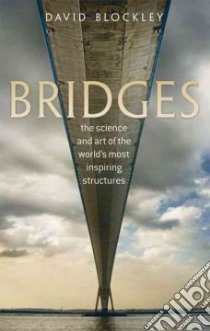- Libreria
- >
- Libri in lingua
- >
- Ingegneria
- >
- Ponti
Bridges - 9780199543595
Un libro in lingua di Blockley David edito da OXFORD UNIVERSITY PRESS, 2010
- € 21.90
- Il prezzo è variabile in funzione del cambio della valuta d’origine
The Brooklyn Bridge, London's Tower Bridge, Sydney's Harbour Bridge, San Francisco's Golden Gate--bridges can be breathtakingly monumental structures, magnificent works of art, and vital arteries that make life vastly easier.
In Bridges, eminent structural engineer David Blockley takes readers on a fascinating guided tour of bridge construction, ranging from the primitive rope bridges (now mainly found in adventure movies), to Roman aqueducts and the timber trestle railway bridges of the American West, to today's modern marvels, such as the Akashi-Kaikyo Bridge, which has the largest span in the world. Blockley outlines the forces at work on a bridge--tension, compression, and shear--and the basic structural elements that combat these forces--beams, arches, trusses, and suspensions (or BATS). As he does so, he explores some of the great bridges around the world, including such lesser-known masterpieces as the Forth Railway Bridge (featured in Alfred Hitchcock's The Thirty-Nine Steps), and describes some spectacular failures, such as the recent bridge collapse in Minnesota or the famous failure of the Tacoma Narrows Bridge in 1940. For instance, Blockley discusses the London's Millennium Bridge--the blade of light across the Thames--which displayed an alarming wobble when opened. He explains that when people walk, they not only exert force directly forward, but also exert a lesser force to the side, and the Millennium Bridge engineers did not consider this tiny lateral movement in their otherwise meticulous design. Amazingly enough, this minor omission caused a wobble severe enough to close the bridge for two years.
Bridge building is a magnificent example of the practical use of science. But as Blockley shows in this illuminating book, engineers must go beyond science, blending technical experience and creativity to build the spans that connect us all.
Informazioni bibliografiche
- Titolo del Libro in lingua: Bridges
- Autore: Blockley David
- Editore: OXFORD UNIVERSITY PRESS
- Data di Pubblicazione: 18 Febbraio '10
- Genere: Lingua Inglese
- EAN-13: 9780199543595


